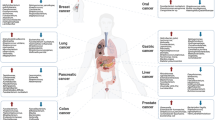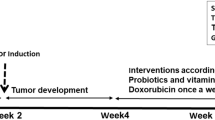Abstract
The diversity of the bacterial community in the gut is closely related to human health. Gut microbes accomplish multiple physiological and biochemical functions. Sitosterols are a series of phytochemicals that have multiple pharmacological activities and are used as cholesterol-lowering drugs in clinical practice. In this study, we investigated the roles of bacteria and short-chain fatty acids (SCFAs) to the anti-colorectal cancer (anti-CRC) effects of sitosterols in BALB/c nude mice. Sitosterols were administered orally and gut microbiota composition and intestinal SCFAs changes were analyzed. The correlation between gut microbiota, SCFAs, and tumor apoptosis was assessed by a series of in vivo and in vitro experiments. Tumor growth in the mice was inhibited by sitosterol-treatment. Mechanistic studies revealed that sitosterol-treatment reduced the expression of PI3K/Akt, promoted the activation of Bad, decreased Bcl-xl, and enhanced cyto-c release, leading to caspase-9 and caspase-3 activation, PARP cleavage, and apoptosis. 16S rDNA analysis revealed that the diversity of microbiota, particularly phyla Bacteroidetes and Firmicutes, reduced dramatically in the gut of tumor-bearing mice, whilst treatment with sitosterols reversed these changes. The levels of SCFAs in the fecal samples of sitosterol-treated mice increased, leading to cancer cell apoptosis in vitro. Moreover, tumor apoptosis was induced after mice received a daily dose of 2 × 108 CFU/0.2 mL Lactobacillus pentosus or 20 mM/0.2 mL SCFAs. Taken together, these results demonstrate that sitosterols maintain a diverse microbial environment and enrich the content of L. pentosus in the gut, leading to the production of beneficial metabolites including SCFAs that promote tumor apoptosis.







Similar content being viewed by others
Abbreviations
- CRC:
-
Colorectal cancer
- SCFAs:
-
Short-chain fatty acids
- NC:
-
Normal control
- TC:
-
Tumor control
- ST:
-
β-Sitosterol
- STG:
-
β-Sitosterol-glucoside
- STGL:
-
β-Sitosterol-glucoside-linoleate
- LAC:
-
Lactobacillus pentosus
References
Arnold M, Sierra MS, Laversanne M, Soerjomataram I, Jemal A, Bray F (2017) Global patterns and trends in colorectal cancer incidence and mortality. Gut 66(4):683–691
Siegel RL, Miller KD, Jemal A (2018) Cancer statistics, 2018. CA Cancer J Clin 68(1):7–30
Akin H, Tözün N (2014) Diet, microbiota, and colorectal cancer. J Clin Gastroenterol 48:S67–S69
Sears CL, Garrett WS (2014) Microbes, microbiota, and colon cancer. Cell Host Microbe 15(3):317–328
Haggar FA, Boushey RP (2009) Colorectal cancer epidemiology: incidence, mortality, survival, and risk factors. Clin Colon Rectal Surg 22(4):191–197
Siegel RL, Miller KD, Jemal A (2015) Cancer statistics, 2015. CA Cancer J Clin 65(1):5–29
Yang D, Zhang M, Gold B (2017) Origin of somatic mutations in beta-catenin versus adenomatous polyposis coli in colon cancer: random mutagenesis in animal models versus nonrandom mutagenesis in humans. Chem Res Toxicol 30(7):1369–1375
Vano YA, Rodrigues MJ, Schneider SM (2009) Epidemiological link between eating habits and cancer: the example of colorectal cancer. Bull Cancer 96(6):647–658
Vargas AJ, Thompson PA (2012) Diet and nutrient factors in colorectal cancer risk. Nutr Clin Pract 27(5):613–623
Sinha R, Chow WH, Kulldorff M, Denobile J, Butler J, Garcia-Closas M, Weil R, Hoover RN, Rothman N (1999) Well-done, grilled red meat increases the risk of colorectal adenomas. Cancer Res 59(17):4320–4324
Sugimura T, Wakabayashi K, Nakagama H, Nagao M (2004) Heterocyclic amines: mutagens/carcinogens produced during cooking of meat and fish. Cancer Sci 95(4):290–299
Augustsson K, Skog K, Jagerstad M, Dickman PW, Steineck G (1999) Dietary heterocyclic amines and cancer of the colon, rectum, bladder, and kidney: a population-based study. Lancet 353(9154):703–707
Johnson RL, Fleet JC (2013) Animal models of colorectal cancer. Cancer Metastasis Rev 32(1–2):39–61
Rosenberg DW, Giardina C, Tanaka T (2009) Mouse models for the study of colon carcinogenesis. Carcinogenesis 30(2):183–196
Lynch HT (1986) Frequency of hereditary nonpolyposis colorectal carcinoma (Lynch syndromes I and II). Gastroenterology 90(2):486–489
Miyoshi Y, Ando H, Nagase H, Nishisho I, Horii A (1992) Germ-line mutations of the APC gene in 53 familial adenomatous polyposis patients. Proc Natl Acad Sci USA 89(10):4452–4456
Chambers WM, Warren BF, Jewell DP, Mortensen N (2005) Cancer surveillance in ulcerative colitis. Br J Surg 92(8):928–936
Huxley RR, Ansary-Moghaddam A, Clifton P, Czernichow S, Parr CL, Woodward M (2009) The impact of dietary and lifestyle risk factors on risk of colorectal cancer: a quantitative overview of the epidemiological evidence. Int J Cancer 125(1):171–180
Larsson SC, Rafter J, Holmberg L, Bergkvist L, Wolk A (2005) Red meat consumption and risk of cancers of the proximal colon, distal colon and rectum: the Swedish mammography cohort. Int J Cancer 113(5):829–834
Slattery ML (2000) Diet, lifestyle, and colon cancer. Semin Gastrointest Dis 11(3):142–146
Eckburg PB, Bik EM, Bernstein CN, Purdom E, Dethlefsen L (2005) Diversity of the human intestinal microbial flora. Science 308(308):1635–1638
Louis P, Hold GL, Flint HJ (2014) The gut microbiota, bacterial metabolites and colorectal cancer. Nat Rev Microbiol 12(10):661–672
Sleeth ML, Thompson EL, Ford HE, Zac-Varghese SEK, Frost G (2010) Free fatty acid receptor 2 and nutrient sensing: a proposed role for fibre, fermentable carbohydrates and short-chain fatty acids in appetite regulation. Nutr Res Rev 23(1):135–145
Muhammad N, Steele R, Isbell TS, Philips N, Ray RB (2017) Bitter melon extract inhibits breast cancer growth in preclinical model by inducing autophagic cell death. Oncotarget 8(39):66226
Azadeh H, Amir G, Vahid S, Razieh R, Hassan A (2014) Effects of β-sitosterol oral administration on the proliferation and differentiation of neural stem cells. J Funct Foods 8:252–258
Wang M, Ma H, Tian C, Liu S, Ye X, Zhou D, Li Y, Hui N, Li X (2017) Bioassay-guided isolation of glycoprotein SPG-56 from sweet potato Zhongshu-1 and its anti-colon cancer activity in vitro and in vivo. J Funct Foods 35:315–324
He K, Hu Y, Ma H, Zou Z, Xiao Y, Yang Y, Feng M, Li X, Ye X (2016) Rhizoma Coptidis alkaloids alleviate hyperlipidemia in B6 mice by modulating gut microbiota and bile acid pathways. Biochim Biophys Acta 1862(9):1696–1709
Chen Y, Gao SG, Chen JM (2015) Serum CA242, CA199, CA125, CEA, and TSGF are biomarkers for the efficacy and prognosis of cryoablation in pancreatic cancer patients. Cell Biochem Biophys 71(3):1287–1291
Engelman JA (2009) Targeting PI3K signalling in cancer: opportunities, challenges and limitations. Nat Rev Cancer 9(8):550–562
Cantley LC (2002) The phosphoinositide 3-kinase pathway. Science 296(5573):1655–1657
Jemal A, Bray F, Center MM, Ferlay J, Ward E, Forman D (2011) Global cancer statistics. CA Cancer J Clin 61(2):69–90
Harris L, Fritsche H, Mennel R, Norton L, Ravdin P (2007) American society of clinical oncology 2007 update of recommendations for the use of tumor markers in breast cancer. J Clin Oncol 25(33):5287–5312
Mayer IA, Arteaga CL (2015) The PI3K/AKT pathway as a target for cancer treatment. Annu Rev Med 67(1):11–28
Engelman JA, Luo J, Cantley LC (2006) The evolution of phosphatidylinositol 3-kinases as regulators of growth and metabolism. Nat Rev Genet 7(8):606–619
Salmena L, Carracedo A, Pandolfi PP (2008) Tenets of PTEN tumor suppression. Cell 133(3):403–414
Manning BD, Cantley LC (2007) AKT/PKB signaling: navigating downstream. Cell 129(7):1261–1274
Guertin DA, Sabatini DM (2007) Defining the role of mTOR in cancer. Cancer Cell 12(1):9–22
Lu J, Fu L, Tang Z, Zhang C, Qin L, Wang J, Yu Z, Shi D, Xiao X, Xie F, Huang W, Deng W (2016) Melatonin inhibits AP-2β/hTERT, NF-κB/COX-2 and Akt/ERK and activates caspase/cyto C signaling to enhance the antitumor activity of berberine in lung cancer cells. Oncotarget 7(3):2985–3001
Ahn J, Sinha R, Pei Z, Dominianni C, Wu J, Shi J, Goedert JJ, Hayes RB, Yang L (2013) Human gut microbiome and risk for colorectal cancer. J Nat Cancer Inst 105(24):1907–1911
O’Keefe SJ (2008) Nutrition and colonic health: the critical role of the microbiota. Curr Opin Gastroenterol 24(1):51–58
de Martel C, Ferlay J, Franceschi S, Vignat J, Bray F, Forman D, Plummer M (2012) Global burden of cancers attributable to infections in 2008: a review and synthetic analysis. Lancet Oncol 13(6):607–615
Schwabe RF, Jobin C (2013) The microbiome and cancer. Nat Rev Cancer 13(11):800–812
Elinav E, Nowarski R, Thaiss CA, Hu B, Jin C, Flavell RA (2013) Inflammation-induced cancer: crosstalk between tumours, immune cells and microorganisms. Nat Rev Cancer 13(11):759–771
Irrazabal T, Belcheva A, Girardin SE, Martin A, Philpott DJ (2014) The multifaceted role of the intestinal microbiota in colon cancer. Mol Cell 54(2):309–320
Garrett WS (2015) Cancer and the microbiota. Science 348(6230):80–86
Sun F, Kong B, Chen Q, Han Q, Diao X (2016) N-nitrosoamine inhibition and quality preservation of Harbin dry sausages by inoculated with Lactobacillus pentosus, Lactobacillus curvatus and Lactobacillus sake. Food Control 73:1514–1521
Bendali F, Kerdouche K, Hamma-Faradji S, Drider D (2017) In vitro and in vivo cholesterol lowering ability of Lactobacillus pentosus KF923750. Benef Microbes 8(2):271–280
Kovatcheva-Datchary P, Arora T (2013) Nutrition, the gut microbiome and the metabolic syndrome. Best Pract Res Clin Gastroenterol 27(1):59–72
Macfarlane GT, Macfarlane S (2012) Bacteria, colonic fermentation, and gastrointestinal health. J AOAC Int 95(1):50–60
Clarke G, Stilling RM, Kennedy PJ, Stanton C, Cryan JF, Dinan TG (2014) Minireview: gut microbiota: the neglected endocrine organ. Mol Endocrinol 28(8):1221–1238
Holzer P, Reichmann F, Farzi A (2012) Neuropeptide Y, peptide YY and pancreatic polypeptide in the gut-brain axis. Neuropeptides 46(6):261–274
Baenke F, Peck B, Miess H, Schulze A (2013) Hooked on fat: the role of lipid synthesis in cancer metabolism and tumour development. Dis Models Mech 6(6):1353–1363
Acknowledgements
This work was financially supported by the Special Program for Scientific and Technical Innovation of Chongqing Social Livelihood (cstc2015shmszx80012, cstc2017shms-kjfp80004), Fundamental Research Funds for the Central Universities (XDJK2017D151, XDJK2017D160), Chongqing Postgraduate Research and Research Innovation Project (CYS17068), Achievement Transfer Program of Institutions of Higher Education in Chongqing (KJZH17105), and County-University Cooperation Innovation Funds of Southwest University (Zx201601).
Author information
Authors and Affiliations
Corresponding author
Ethics declarations
Conflict of interest
The authors declare that there are no potential conflicts of interest.
Electronic supplementary material
Below is the link to the electronic supplementary material.
Rights and permissions
About this article
Cite this article
Ma, H., Yu, Y., Wang, M. et al. Correlation between microbes and colorectal cancer: tumor apoptosis is induced by sitosterols through promoting gut microbiota to produce short-chain fatty acids. Apoptosis 24, 168–183 (2019). https://doi.org/10.1007/s10495-018-1500-9
Published:
Issue Date:
DOI: https://doi.org/10.1007/s10495-018-1500-9




